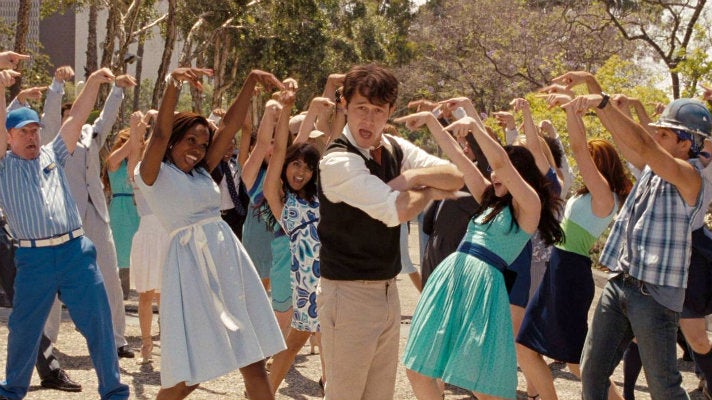Read on for information about historic locations that were featured in the 2009 Fox Searchlight film (500) Days of Summer, courtesy of the Los Angeles Conservancy. The film is a romantic comedy, but many have pointed out that the City of Los Angeles and its stunning architecture play almost as important a role as the young couple, Tom and Summer.
San Fernando Building
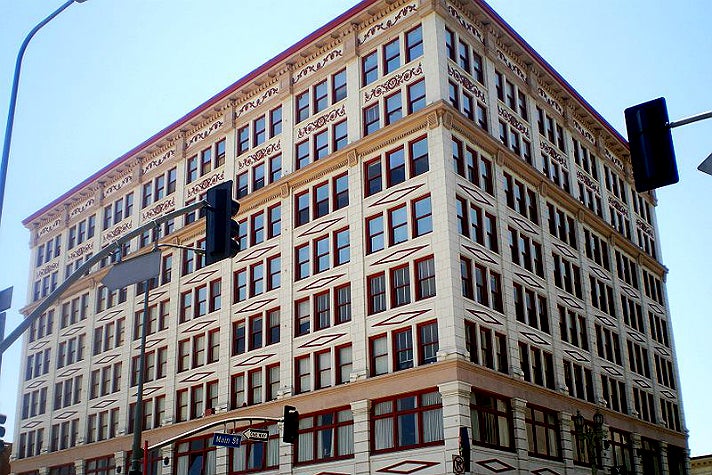
San Fernando Building, 400 South Main Street (at Fourth Street)
*Los Angeles Historic-Cultural Monument #728
*Listed in the National Register of Historic Places
In the film, the San Fernando Building serves as the video & record store.
- The original building was built by John F. Blee in 1907
- The two top stories were added on by R. B. Young in 1911
- Designed in the Renaissance Revival style
- Commissioned by James B. Lankershim, one of the largest landholders in California (his father Isaac helped develop the San Fernando Valley for farming)
- Originally had a café, billiard room and Turkish bath in the basement for tenants
- Achieved local attention in 1910, when a series of police raids occurred on the sixth floor due to illegal gambling in the rooms
- Redeveloped by Gilmore Associates and reopened in 2000 as 70 loft-style apartments; one of the early projects that sparked Downtown’s current renaissance
Hotel Barclay (Van Nuys Hotel)

Look diagonally across Main Street (northwest corner of Fourth & Main):
Hotel Barclay, 103 West Fourth Street
*Los Angeles Historic-Cultural Monument #288
In the film, the Barclay lobby serves as the hangout for Tom and his buddies.
- Built by Morgan and Walls in 1896
- Designed in the Beaux-Arts style with Romanesque features (which are less detailed and ornate than the more formal Beaux-Arts style)
- Look up to the top of the building to see “The Van Nuys”
- Commercial venture by Isaac Newton Van Nuys, one of L.A.’s wealthiest businessmen and landowners
- Opened in 1897 as the Van Nuys Hotel, one of the finest in the city, with the latest amenities
- First hotel to provide telephone and electric service in every room; “a neat device for the electrical heating of curling irons in each room is a new feature of special interest to the ladies” (Los Angeles Times)
- Fourth Street lobby has many original elements, including ceiling decorations, columns, arched doorways, stained-glass windows with old-fashioned scenes, and a crest with “V. N.” held up by sea horses
- The oldest continuously operating hotel in Los Angeles, now a low-income residential hotel
Continental Building (Braly Block)

Cross Main Street at Fourth Street (toward the Barclay Hotel), go one block to Spring Street; on your left will be:
Continental Building, 408 South Spring Street
*Los Angeles Historic-Cultural Monument #730
*Part of the National Register: listed Spring Street Financial District
In the film, this is one of Tom’s favorite buildings, as viewed from Tom’s bench; identified by Tom as “L.A.’s first skyscraper.”
- Built by John Parkinson between 1902 and 1904
- One of the first examples of the Beaux-Arts business block
- At 175 feet, considered the city's first skyscraper
- Completed shortly before the city established a 130-foot building height limit in 1905 (later raised to 150 feet); remained the city's tallest building (in terms of occupied space) for more than 50 years (except City Hall, which was exempted from the limit by public vote)
- First floor has been altered, but the second story retains its stone block design
- Notice the row of lion heads on the projecting cornice made of pressed galvanized tin
- Served as office space and later housed many banks
- Now owned by Gilmore Associates, which converted it into 56 loft-style apartments, opened in 2001
Bradbury Building
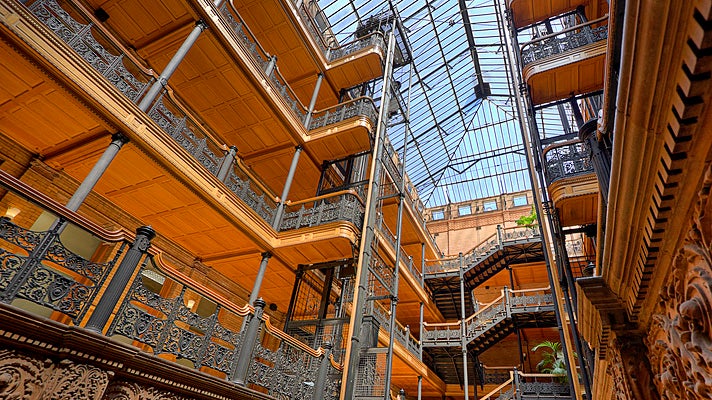
Continue west on Fourth another block; turn right on Broadway and head north to Third Street. On your right will be:
Bradbury Building, 304 South Broadway
*Los Angeles Historic-Cultural Monument #6
*State Landmark
*Listed in the National Register of Historic Places
In the film, this is the site of an important meeting for Tom.
- Built by Sumner Hunt and/or George H. Wyman (disputed) in 1893
- Built in the Victorian Romanesque style
- Simple sandstone and brown brick exterior gives way to five-story interior court filled with light from the glass roof, cast-iron railings and open-cage elevators
- Hydraulic elevators originally powered by steam-derived boilers in the basement
- Lewis Bradbury was a mining millionaire who moved to L.A. later in life to become a real estate investor
- The oldest commercial building in the center city
- Purchased by Ira Yellin in 1989; renovated as a key part of his Grand Central Square project, which foreshadowed downtown’s current renaissance by a decade
- Has long been a popular filming location, probably best known for the 1982 sci-fi epic Blade Runner
Million Dollar Theater

Across Broadway, at Third Street:
Million Dollar Theater, 307 South Broadway
*Part of the National Register-listed Broadway Theatre and Commercial District
*Photo by Larry Underhill
In the film, Tom & Summer see The Graduate here.
- Built by Albert C. Martin in 1918
- The interior was done by William Lee Woollett
- The exterior sculpture was done by by Joseph Mora
- Sid Grauman’s first Los Angeles theatre
- One of the earliest movie palaces in the U.S. and, with more than 2,300 seats (originally), one of the largest
- Designed in the ornate Churrigueresque style
- Lavish exterior terra-cotta ornamentation by Mora includes bison heads, longhorn skulls and allegorical figures representing the arts
- The name Million Dollar comes from the combined original costs of the land and the building
- Originally had a two-story exterior foyer/lobby; has been altered over the years, though some details, such as murals, remain underneath
- From 1949 until the late 1980s (when it closed), the theater was a major center of Latino entertainment, with Mexican films and traveling vaudeville shows from Latin America
- Operated as a Spanish-language church in the 1990s
- Reopened in 2008 after a year-long, million-dollar refurbishment
- Upper stories originally housed office space; now apartments
Grand Central Market
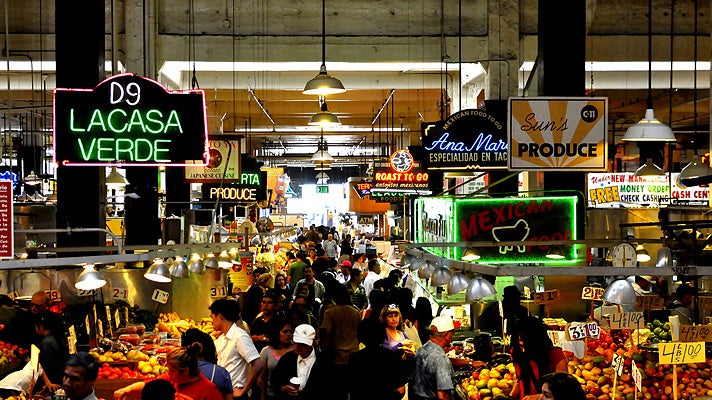
To the left of the theater:
Grand Central Market, 315 South Broadway
John Parkinson, 1897
*Listed in the National Register of Historic Places
This was the site of a deleted scene from the film, in which Tom and Summer are shopping for fruit.
- Built by retired Ohio entrepreneur Homer Laughlin, founder of the Homer Laughlin China Company
- The city’s first fireproofed and steel-reinforced structure
- In 1905, building was expanded through to Hill Street
- Market opened in 1917
- Today has more than 50 vending stalls, each privately owned and operated
- Building was rehabilitated in the early 1990s as part of the Yellin Company’s Grand Central Square project
-
Project removed a tile façade added in the 1960s to reveal the second-story windows and many of the original Beaux-Arts details
Go through Central Market to Hill Street (or down Third Street, then left on Hill).
Tom's Bench
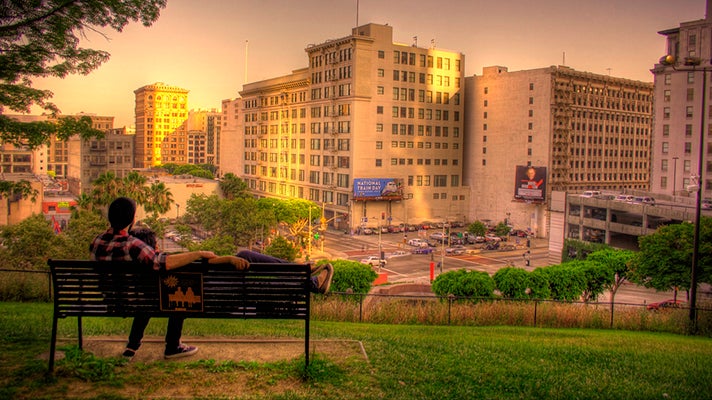
Cross Hill Street and go all the way up the 100+ steps to:
Angels Knoll/Bunker Hill, 356 South Olive Street
In the film, this is Tom’s favorite L.A. spot, offering a great view of (mostly) pre-war buildings. As Tom shows Summer the architecture, he says words along the lines of, "There’s so much beauty here. Sure the street level isn’t much to look at, but if you look up, there’s some exciting stuff going on. If it were up to me, I’d get people to notice!”
NOTE: Tom's Bench is currently inaccessible to the public. It’s still visible through a chainlink fence.
Redwood Bar & Grill
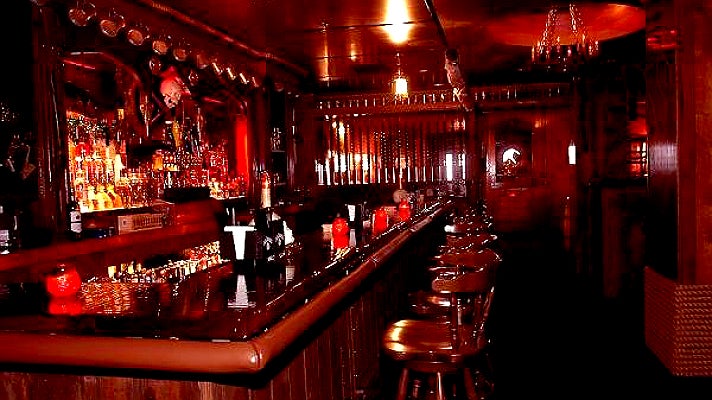
If you’re as thirsty as a pirate, head north on Hill to Second Street, to:
Redwood Bar & Grill, 316 West Second Street
In the film, this serves as the office bar where Tom, Summer and coworkers indulge in drunken karaoke.
Other Downtown Film Locations
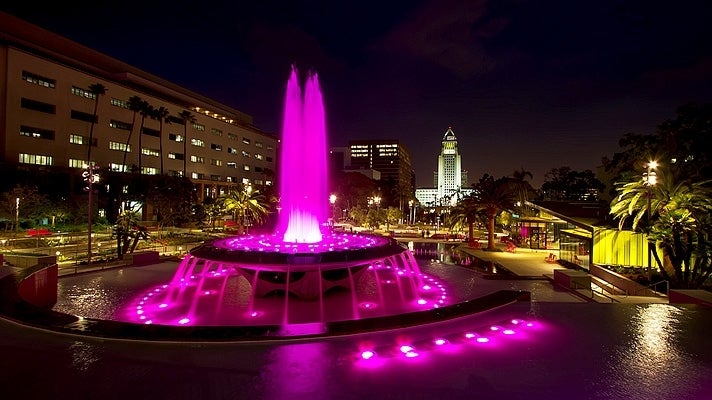
*FENTON BUILDING (circa 1925; aka Roseland dance hall)
833-835 South Spring Street, between Eighth and Ninth Streets
In the film, this is where Tom works as a copywriter for a greeting card company.
*ARTHUR J. WILL MEMORIAL FOUNTAIN (1965)
Civic Center Mall, between First and Temple Streets, near Grand Avenue
In the film, this is where Tom dances to the Hall & Oates song “You Make My Dreams Come True.” The fountain is a mid-century classic, recently restored as part of the Grand Park project.
*FINE ARTS BUILDING (Walker and Eisen, 1926)
811 West Seventh Street
This is one of Tom’s favorite buildings; he incorrectly singles out architects Walker and "Eisner."
*EASTERN COLUMBIA BUILDING (Claud Beelman, 1930)
849 South Broadway, across from the Orpheum Theatre
Another one of Tom’s favorites.
*BROADWAY BAR
830 South Broadway, next to the Orpheum Theatre
In the film, this is where Tom defends Summer.
Many thanks to the Los Angeles Conservancy, Fox Searchlight, Michael Chickey, Martin J. Cummins and Harry Medved.
The Los Angeles Conservancy is a nonprofit organization devoted to preserving the historic architectural and cultural resources of Los Angeles County.




